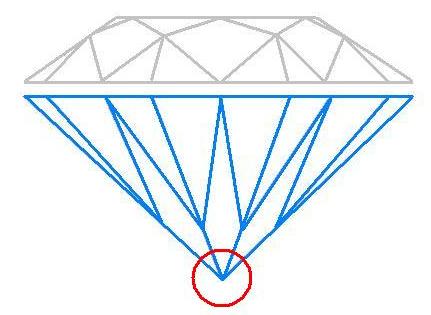The diamond culet is the flat surface at the very bottom of the diamond, specifically at the pavilion’s tip. It plays a role in the diamond’s overall appearance, cut quality, and how it interacts with light.
Key Points about the Diamond Culet:
Location:
The culet is located at the very bottom of the diamond, at the pavilion, which is the lower portion of the diamond beneath the girdle.
It forms part of the cut and is essentially the small facet at the apex of the pavilion, where the diamond tapers to a point (in traditional cuts like round brilliant).
Function:
Purpose: The culet serves to prevent the diamond from being damaged during the cutting process. If the point of the pavilion were left unpolished or sharp, it could easily chip or break. The culet helps avoid this by giving the diamond a flat surface at the tip.
Light Interaction: The culet doesn’t significantly affect the light return or brilliance of the diamond, but its size and presence can influence the appearance of the diamond from the bottom.
Culet Size:
None: Some diamonds are cut without a culet at all, especially if the diamond has a sharp, pointed pavilion (this is often seen in high-quality round brilliant cuts). These diamonds may be labeled as “no culet” or “culet: none” in grading reports.
Small: A small culet is typically 0.1% to 0.3% of the diameter of the diamond. This is most common in diamonds cut for optimal brilliance.
Medium, Large, or Very Large: Larger culets are rare but can be found in older or antique diamonds, as well as some cushion or asscher cuts. Larger culets can sometimes give the diamond an unusual look and may reduce the diamond’s overall brilliance and desirability.
Impact on Diamond’s Appearance:
A larger culet may be visible from the top of the diamond, especially in diamonds with a larger table or shallow cut. It can detract from the diamond’s brilliance by allowing light to escape more easily.
A small culet or no culet at all is generally preferred in modern diamond cuts, as it maintains the maximum light performance and enhances the sparkle.
Culet and Clarity:
A large culet can sometimes be considered an inclusion when graded for clarity, as it may affect the overall symmetry of the diamond. However, a small or no culet typically doesn’t affect the diamond’s clarity.
The size and presence of the culet are typically noted in a diamond’s grading report, but it is not a major factor in the diamond’s clarity grade unless it affects the overall symmetry or appears as a significant visible feature.
Culet and Cut Quality:
While the culet doesn’t directly influence the light performance or brilliance, the proportions and symmetry of the cut, including the culet, are important for achieving an optimal cut grade.
Symmetry: A well-formed, symmetrical culet contributes to the diamond’s overall cut quality, enhancing its visual appeal.
Summary:
The diamond culet is the small flat facet at the tip of the diamond’s pavilion, designed to prevent damage during the cutting process.
Culet Size: It can be absent (no culet), small, medium, or large, with smaller culets generally preferred for better light return and brilliance.
Impact on Appearance: A larger culet may be visible from the top and can reduce the diamond’s sparkle. A small culet or no culet is preferred in modern cuts.
Clarity and Symmetry: The size of the culet can affect the diamond’s clarity and symmetry, but typically does not impact overall clarity unless it’s large or noticeably visible.

